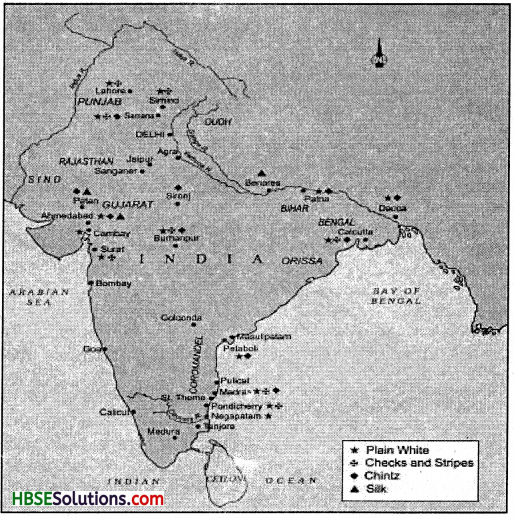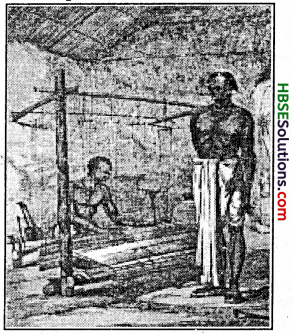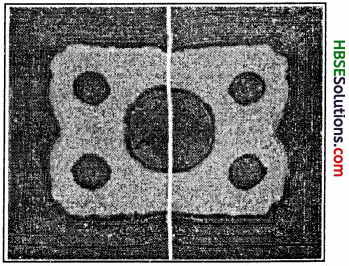Haryana State Board HBSE 8th Class Social Science Solutions History Chapter 7 Weavers, Iron Smelters and Factory Owners Textbook Exercise Questions and Answers.
Haryana Board 8th Class Social Science Solutions History Chapter 7 Weavers, Iron Smelters and Factory Owners
HBSE 8th Class History Weavers, Iron Smelters and Factory Owners Textbook Questions and Answers
LETS IMAGINE
Imagine you are a textile weaver in late- nineteenth-century India. Textiles produced in Indian factories are flooding the market. How would you have adjusted to the situation?
Answer:
I would have contacted the agents of different European companies and had bargained. I would have produced fine quality of textile and worked very hard in my working unit. I would have requested to my local merchants to increase the supply of the textiles.
LETS RECALL
Question 1.
What kinds of cloth had a large market in Europe?
Answer:
- European traders preferred fine cotton cloth from India carried by Arab merchants in Mosul in present-day Iraq.
- The Portuguese took back cotton textiles called ‘calico’ to Europe.
- Europeans also ordered printed cotton cloth called ‘chintz’.
- From the 1680’s there started a craze for printed cotton textiles in England and Europe mainly for their exquisite floral designs, fine texture and relative cheapness.
- Rich people of England including the Queen herself wore clothes of Indian fabric.
Question 2.
What is Jamdani?
Answer:
Jamdani is a fine muslin on which decorative motifs are woven on the loom, typically in grey and white.
Question 3.
What is bandanna?
Answer:
The word ‘bandanna’ refers to any brightly coloured and printed scarf for the neck or head.
Question 4.
Who are the Agarias?
Answer:
Agaria is a community of iron smelters who specialized in the field of craft.
![]()
Question 5.
Fill in the blanks :
(a) The word chintz comes from the word
(b) Tipu’s sword was made of steel.
(c) India’s textile exports declined in the century.
Answer:
(a) Chhint
(b) Wootz
(c) eighteenth
LETS DISCUSS
Question 6.
How do the names of different textiles tell us about their histories?
Answer:
There are various examples of names of textiles derived from different languages. The English word Chintz is derived from Chhint, a Hindi word. Originally the term bandanna derived from the word ‘bandhna’ (Hindi for tying). The widespread use of such words shows how popular Indian textiles had become in different parts of the world.
Question 7.
Why did the wool and silk producers in England protest against import of Indian textiles in the early eighteenth century?
Answer:
Worried by the popularity of Indian textiles, wool and silk makers in England began protesting against the import of Indian cotton textiles. In 1720, the British government enacted a legislation banning the use of printed cotton textiles too.
Question 8.
How did the development of cotton industries in Britain affect textile producers in India?
Answer:
(a) Indian textiles now had to compete with British textiles in the European and American markets.
(b) Exporting textiles to England also became increasingly difficult since very high duties were imposed on Indian textiles imported to Britain.
Question 9.
Why did the Indian iron smelting decline in the nineteenth century?
Answer:
- The new forest laws led to the decline of craft of iron smelting.
- When the colonial government prevented people from entering the reserved forests, the iron smelters could not find wood for charcoal.
- Even when they were granted access, the iron smelters had to pay a very high tax to the forest department for every furnace used. This reduced their income.
- Moreover, iron and steel was being imported from Britain.
Question 10.
What problems did Indian textile industry face during its development?
Answer:
- Indian textiles now had to compete with British textiles in European and American markets.
- Exporting textiles to England also became increasingly difficult since very high duties were imposed on Indian textiles imported to Britain.
- European companies had stopped buying Indian goods and their agents no longer gave out advances to weavers to secure supplies.
- By 1830s, two-thirds of all the cotton clothes worn by Indians were made of clothes produced in Britain.
![]()
Question 11.
What helped TISCO expand steel production during First World War?
Answer:
- Steel produced in Britain now had to meet the demands of war in Europe. So imports of British steel into India declined.
- The Indian Railways turned TISCO for supply of rails.
- As the war dragged on for several years, TISCO had to produce shells and carriage wheels for the war.
- By 1919, the colonial government was buying 90% of the steel manufactured by TISCO.
LETS DO
Question 12.
Find out about the history of any craft around the area you live. You may wish to know about the community of craftsmen, the changes in the techniques they use and the market they supply. How have these changed in the past 50 years?
Answer:
Not from examination point of view. Do it yourself,
Question 13.
On a map of India, locate the centres of different crafts today. Find out when they came up.
Answer:

HBSE 8th Class History Weavers, Iron Smelters and Factory Owners Important Questions and Answers
Very Short Answer Type Questions
Question 1.
Give the general name for all cotton textiles.
Answer:
Calico.
Question 2.
Which two industries were crucial for the industrial revolution in the modern world ?
Answer:
- Textile industry
- Iron and Steel industry.
Question 3.
Who invented the spinning jenny?
Answer:
John Kaye.
Question 4.
Who invented the steam engine?
Answer:
Richard Awkright.
Question 5.
Name the foremost textile centre in the 18th century.
Answer:
Dacca, Eastern Bengal, present day Bangladesh.
![]()
Question 6.
When was India the world’s largest producer of cotton textile?
Answer:
Around 1750, before the British conquered Bengal.
Question 7.
What is the name given to a dyer?
Answer:
Rangrez.
Question 8.
What is Chintz?
Answer:
Chintz is a printed cotton cloth with small and colourful flowery designs.
Question 9.
When was the charkha adopted as the centre of flag of INC?
Answer:
In 1931.
Question 10.
Where and when was the first cotton mill set-up in India?
Answer:
Bombay, 1854.
Question 11.
Give the anglicised version of the word-Ukku.
Answer:
Wootz.
Short Answer Type Questions
Question 1.
Why is “muslin” named so?
Answer:
European traders first encountered fine cotton doth from India carried by Arab merchants in Masul in present-day Iraq. So they began referring to all finely woven textiles as “muslin” a word acquired wide currency.
Question 2.
Why was there a craze for chintz in England?
Answer:
From the 1680s there started a craze for printed Indian cotton textiles mainly for their exquisite floral designs, fine texture and relative cheapness.
Question 3.
Define Jamdani.
Answer:
Jamdani is a fine muslin on which decorative motifs are woven on the looms, typically in grey and white.
Question 4.
What is spinning jenny? How was its useful?
Answer:
A spinning jemmy is a machine by which a single worker could operate several spindles on to which thread was spun. When the wheel was turned all the spindles rotated. This increased productivity of traditional spindles.
Question 5.
Who were the weavers?
Answer:
Weavers often belonged to the community that specialized in weaving whose skills were passed «en from one generation to another.
Example : Tanti weavers, Bengali; Devangs of South Indiaetc.
![]()
Question 6.
“Exporting textiles to England also became increasingly difficult.” Give reason.
Answer:
Exporting textiles to England also became increasingly difficult since very high duties were imposed on Indian textiles imported to Britain.
Question 7.
Mention the occupation of weavers and spinners who lost their livelihood.
Answer:
Many weavers became agricultural labourers. Some migrated to cities in search of work and yet others went out to work in African and South American plantations. Some of these handloom weavers started work in the new, cotton mills.
Question 8.
Define smelting.
Answer:
The process of obtaining a metal from rock (or soil) by heating it to a very high temperature.
Question 9.
What was the use of Bellows?
Answer:
Women worked with bellows, pumping air that kept Use charcoal burning.
Question 10.
What was the aim of Dorabji Tata and Charles Weld travelling in Chattisgarh?
Answer:
Charles Weld, an American geologist and Dorabji Tata, the eldest son of Jamshedji Tata, were travelling in Chattisgarh in search of non ore deposits spending months on a costly venture looking for sources of good iron ere.
Question 11.
“Despite being the finest ere, Rajhara hills was not the Tatas choice.” Why?
Answer:
Rajahara hills was a dry region and due to the necessity of water for running a factory, Tatas had to continue their search for a more suitable place to set-up their factory.
Question 12.
How dad ffiaropeaa companies make enormous profits out of Indian textiles during 18th century ?
Answer:
European trading companies – the Dutch, the French and the English pm-chased cotton and silk textiles in India by importing silver.
Question 13.
Why was the sword of Tipu Sultan so special ?
Answer:
This sword had an incredibly hard and sharp edge that could easily rip through the opponent’s armour. This quality of the sword came from a special type of high carbon Steel called Wootz.
Question 14.
How were the furnaces built in villages of lndia?
Answer:
(a) The fin-nances were most often built of day and sun-dried bricks.
(b) The smelting was dane by men while women worked the bellows, pumping air .that kept the charcoal burning.
Question 15.
When was steam engine invented and by whom? What was its impact?
Answer:
(a) Steam engine was invented in 1786 by Richard Arkwright.
(b) Cloth could now be woven in immense quantities and cheaply too.
Question 16.
Name some communities who were famous for weaving.
Answer:
(a) The tanti weavers of Bengal
(b) the julahas or momin weavers of north India
(c) sale and kaikollar and devanges of south India are some of the communities famous for weaving
![]()
Long Answer Type Questions
Question 1.
How does word “bandanna” reveal history and present day textile world?
Answer:
The word bandanna now refers to any brightly coloured and printed scraf for the neck or head. Originally, the (term derived from the word “bandhna” (Hindi for tying) and referred to a variety of brightly coloured clothes produced through a method of tying and dyeing. It was a cloth that was produced as it was seamed together.
Question 2.
What technological innovations were made during eighteenth century? Why?
Answer:
Competition with Indian textiles also led to a search for technological innovations in England. In 1764, Spinning Jenny was invented by John Kaye which increased the productivity of traditional spindles. In 1786, the invention of the steam engine by Richard Awkright revolutionised cotton textile in many ways. These helped cloth get woven in immense quantities and cheaply too.
Question 3.
Explain in detail the process of production of handloom weaving.
Answer:
(а) Spinning : Using charkhas and taklis, fibres could be spun by women. The thread was spun on the charkha and rolled on the takli.
(b) Weaving: After spinning, weaving was done by men from a thread to a cloth/ fabric.
(c) Dyeing: For obtaining coloured textiles, the thread was dyed by the dyer known as rangrez.
(d) Printing : For obtaining printed cloth, the weavers needed the help of specialist block printers called Chhipigars. However, dyeing and printing were optional tasks.
Question 4.
“Even after extreme failures, handloom weaving did not completely die in India.” Why?
Answer:
Handloom weaving did not die in India because:
(a) Some types of clothes could not be supplied by the machine such as saris with intricate borders or fabrics with traditionally woven patterns.
(b) These had a wide demand by both the rich and middle class people.
(c) They also met the demands of poor as coarse cloth was not produced by textile manufacturers in Britain.
Question 5.
How did charkha become an important part of national movement?
Answer:
In the late nineteenth century, Mahatma Gandhi urged people to boycott imported textiles and use hand-spun and hand- woven clothes. These were, spun using a charkha. Khadi gradually became a symbol of nationalism during the National Movement. In this case, the charkha was the traditional spinning instrument that came to represent India and it was put at the centre of the tricolour flag of the Indian National Congress adopted in 1931.
Question 6.
Which were the major centres of weaving in the late 18th century India?
Answer:
The textile production was concentrated in the following four regions in the early 18th century :
(i) Bengal was one of the most important centrs. Located along the numerous rivers in the delta, the production centres in Bengal could easily transport goods to distant places.
(ii) Dacca in Eastern Bengal was the foremost textile centre in the 18th century. It was famous for its mulmul and jamdani weaving.
(iii) A cluster of cotton weaving centres was along the coromandel coast stretching from Madras to northern Andhra Pradesh.
(iv) On the western coast, there were important weaving centres in Gujarat.
![]()
Question 7.
What were the various stages of textile production in India?
Answer:
(a) The first stage of production was spinning which was mostly done by women. The thread was spun on the charkha and rolled on the takli.
(b) Then thread was woven into cloth by the weaver which was generally done by men.
(c) For coloured textiles, the thread was dyed by the dyer.
(d) For printed cloth, the weavers needed the help of specialist block printers.
Question 8.
What were the effect of the decline of Indian textiles in the 19th century?
Answer:
(a) By the beginning of the 19th century, english-made cotton textiles successfully ousted Indian goods from their traditional markets in Africa, America and Europe.
(b) Thousands of weavers in India became jobless. Bengal weavers were the worst hit.
(c) English and European companies stopped buying Indian goods and giving advances to weavers to secure supplies.
(d) By the 1830s, British cotton cloth flooded Indian markets. Infact, by the 1880s two-thirds of all the cotton clothes worn by Indians were made of cloth produced in British.
Picture Based Questions
Question I.
Look at the given pictures and answer the questions that follow:

Question 1.
What are the Tanti weavers doing?
Answer:
The tanti weavers here at work in the pit loom.
Question 2.
Where might they hail from?
Answer:
They might hail from Bengal.
Question II.
Look at the given pictures and answer the questions that follow:

Question 1.
What pattern is shown?
Answer:
Bandanna.
Question 2.
Where is it mainly produced?
Answer:
Rajasthan, Gujarat.
Question 3.
Why does the line separate two patterns?
Answer:
This is because two tie and dye patterns are seamed together with gold thread embroidery.
![]()
Weavers, Iron Smelters and Factory Owners Class 8 HBSE Notes
- Spinning Jenny: A machine by which a single worker could operate several spindles on to which thread was spun. When the wheel was turned all the spindles rotated.
- Aurang : A Persian term for a warehouse – a place where goods are collected before being sold, also refers to a workshop.
- Smelting : The process of obtaining a metal from rock (or soil) by heating it to a very high temperature, or of melting objects made from metal in order to use the metal to make something new.
- Bellows: A device or equipment that can pump air.
- Slag heaps: The waste left when smelting a metal.
- Warehouse: A place where goods are collected before being sold.